Large language models (LLMs) like GPT-4 have demonstrated impressive capabilities in generating human-like text. Recent explorations go beyond text generation, framing LLMs as the core controller of agents and autonomous agents that can not just write but also reason, act, and learn.
LLMs have the potential to function as artificial general intelligence systems. They are rapidly transforming from passive language systems into active, goal-oriented agents capable of autonomous reasoning and task completion.
This development marks a seismic shift in artificial intelligence and promises to revolutionize how humans interact with machines.
What is a Large Language Model (LLM) Agent
An LLM agent is an artificial intelligence system that utilizes a large language model (LLM) as its core computational engine to exhibit capabilities beyond text generation, including conducting conversations, completing tasks, reasoning, and can demonstrate some degree of autonomous behaviour.
LLM agents are directed through carefully engineered prompts that encode personas, instructions, permissions, and context to shape the agent's responses and actions.
A key advantage of LLM agents is their ability to varying degrees of autonomy. Based on the capabilities granted during the design phase, agents can exhibit self-directed behaviours ranging from purely reactive to highly proactive.
With sufficient prompting and access to knowledge, LLM agents can work semi-autonomously to assist humans in a range of applications, from conversational chatbots to goal-driven automation of workflows and tasks.
Their flexibility and language modelling strengths enable new possibilities for customizable AI partners that understand natural language prompts and collaborate with human oversight.
To increase autonomous capabilities, LLM agents require access to knowledge bases, memory, and reasoning tools. Prompt engineering equips agents with advanced skills in analysis, project planning, execution, reviewing past efforts, iterative refinement, and more. With sufficient knowledge and prompts, agents can manage relatively self-contained workflows with human oversight.
This ultimately directs the agent's behaviours by encoding personas, instructions, and permissions into carefully crafted prompts. Users efficiently guide the agent by providing interactive prompts in response to the AI's output. Well-designed prompts allow seamless human-AI collaboration.
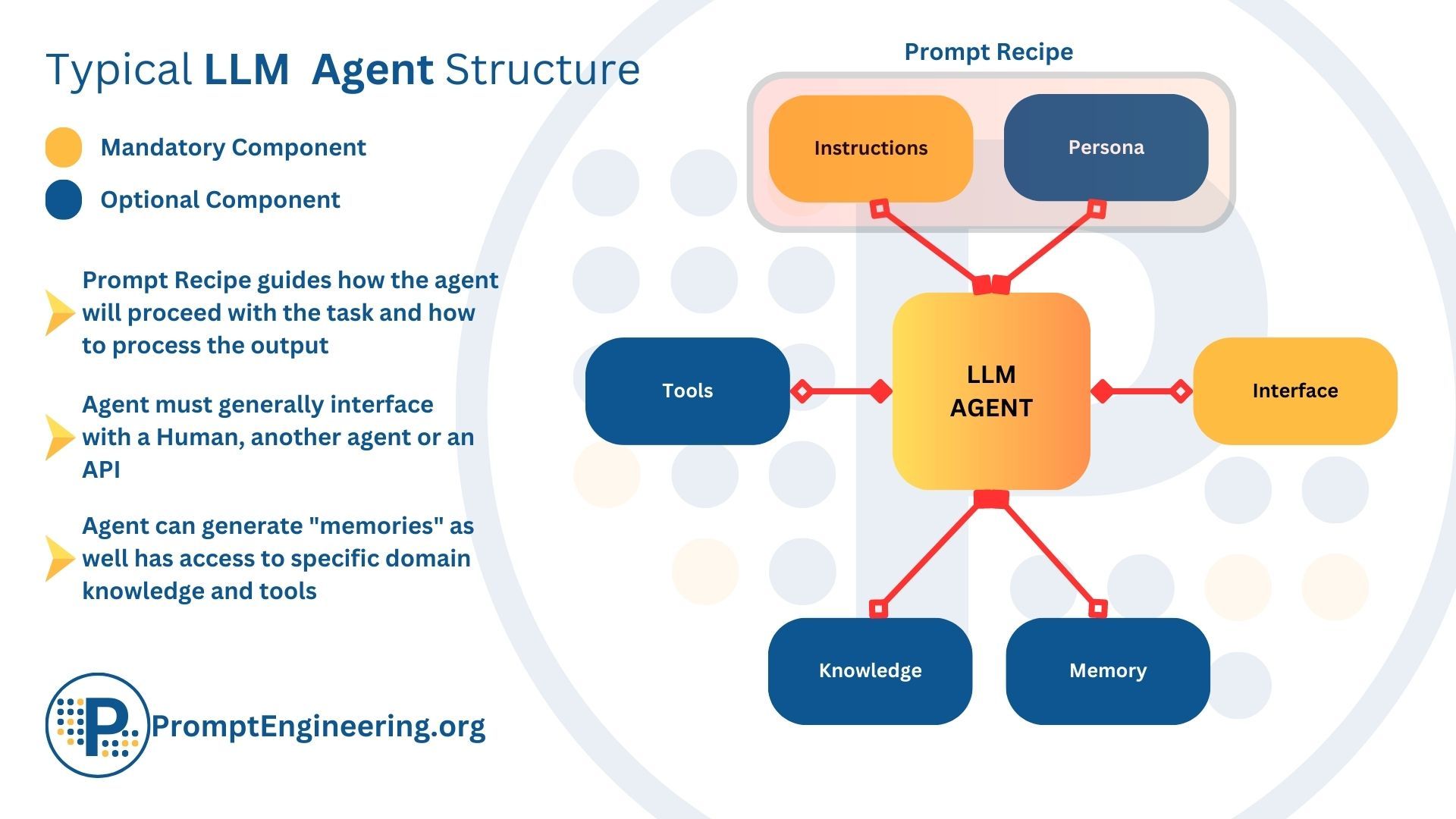
Key Capabilities of LLM Agents
- LLM agents leverage the innate language capabilities of LLMs to understand instructions, context, and goals. This allows them to operate autonomously and semi-autonomously based on human prompts.
- LLM agents can utilize suites of tools - calculators, APIs, search engines - to gather information and take action towards completing assigned tasks. They are not confined to just language processing.
- LLM agents can exhibit chain-of-thought reasoning, tree-of-thought and other prompt engineering concepts, making logical connections to work towards conclusions and solutions to problems. Their reasoning expands beyond just textual comprehension.
- LLM agents can generate tailored text for specific purposes - emails, reports, marketing materials - by incorporating context and goals into their language production skills.
- Agents can be fully autonomous or semi-autonomous, with varying levels of user interaction required.
- Agents can couple different AI systems, such as large language models with image generators, for multifaceted capabilities.
The Evolution from LLMs to Agents - A Quick Review
Large language models (LLMs) began as passive systems focused solely on statistical language modelling. Early LLMs like GPT-2 could generate or summarize text impressively but lacked any notion of goals, identity, or agency. They were models without the motivation to act.
Over time, users realized that careful prompt engineering could elicit more human-like responses from LLMs. Personas and identities were encoded into prompts to shape the LLMs' tone, opinions, and knowledge. More advanced prompting techniques allowed LLMs to plan, reflect, and exhibit rudimentary reasoning.
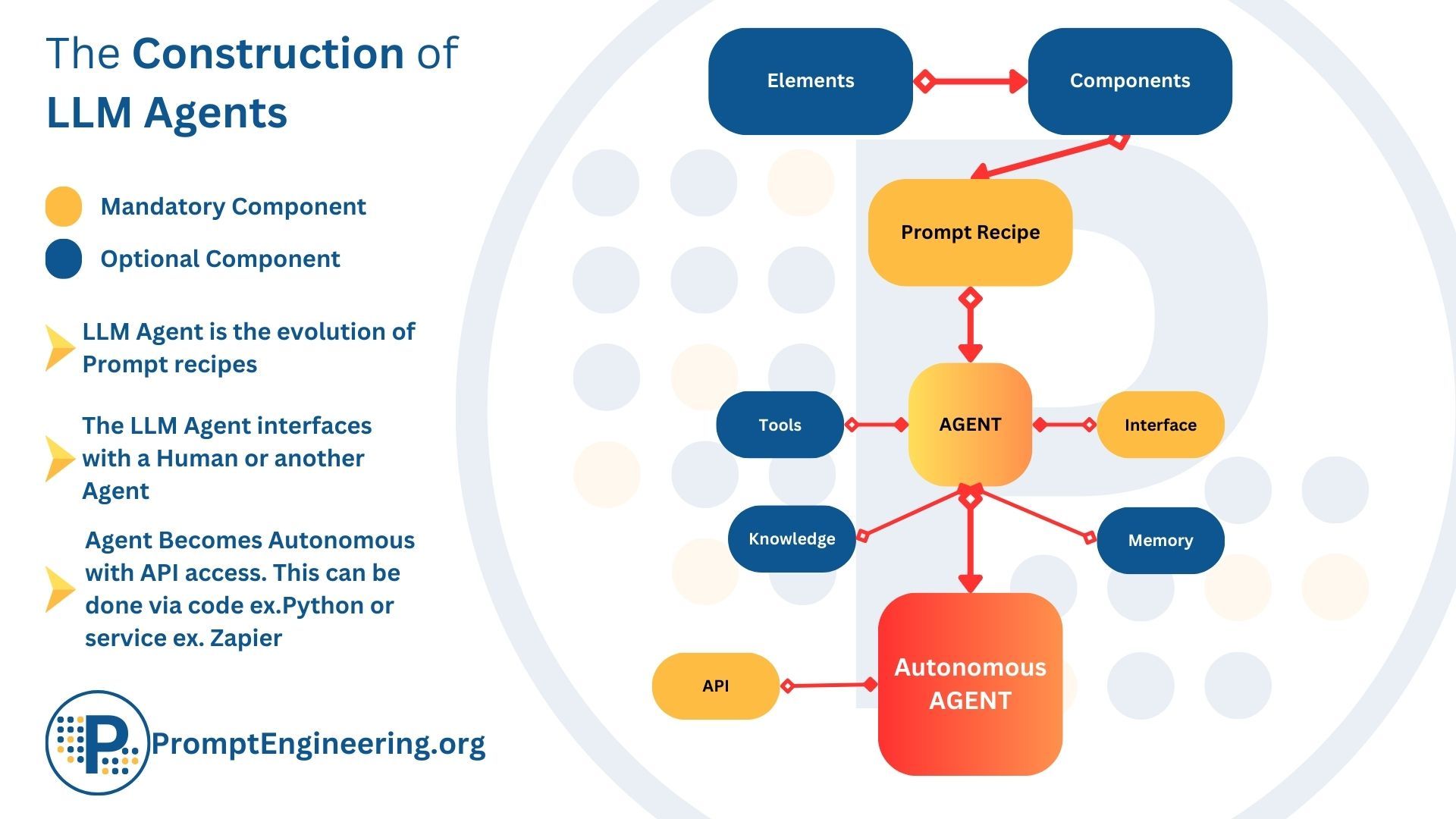
This prompted the rise of LLM-based agents designed intentionally to simulate conversation or achieve defined tasks. Conversational agents like ChatGPT adopted personas to engage in remarkably human-like dialogue. Goal-oriented agents marshalled LLMs' reasoning capabilities towards executing workflows.
Both agent types benefited enormously as prompt engineering practices matured. Prompt recipes enabled predefined structures optimized for consistency and efficiency. Modular components and elements allowed greater customization.
Equipping agents with external memory, knowledge integration, and tool integration expanded their capabilities drastically. Multi-agent coordination further unlocked new potential. Underpinning it all, iterative prompt engineering remained key to directing the agents' behaviours.
Today, the line between passive LLMs and interactive, semi-autonomous agents has blurred substantially. Agents exhibit impressive agency, leveraging their LLMs to collaborate on prompts rather than just respond. The evolution continues rapidly, as prompt engineering coaxes ever-more advanced reasoning, learning, and skills from LLMs.
Overview of the prompt cycle
The iterative prompt cycle is key to facilitating natural conversations between users and LLM agents:
- User Prompt: The user provides an initial prompt to launch the conversation and direct the agent towards a specific task or discussion topic.
- Prompt Engineering: The creation of the prompt is carefully engineered to provide optimal instructions and context to the LLM. Factors like tone, point of view, and conversational style help steer the LLM's response.
- LLM Generation: The LLM processes the encoded prompt within its current context window to generate a relevant textual response. The response displays nuances reflecting the prompt engineering.
- LLM Autoregressive Chaining: LLM-generated text is recursively added to the context window. This allows the LLM to build on its own responses, chaining output autoregressively.
- User Feedback Loop: The user provides follow-up prompts in response to the LLM's output. This feedback channels the conversation through further iterations of the cycle.
- Context Expansion: With each cycle, the context window expands, allowing the LLM agent to accumulate knowledge and better understand the user's conversational goals.
- Repeated Cycling: Over many cycles, the LLM agent converges on solutions, reveals deeper insights, and maintains topic focus within an evolving dialogue.
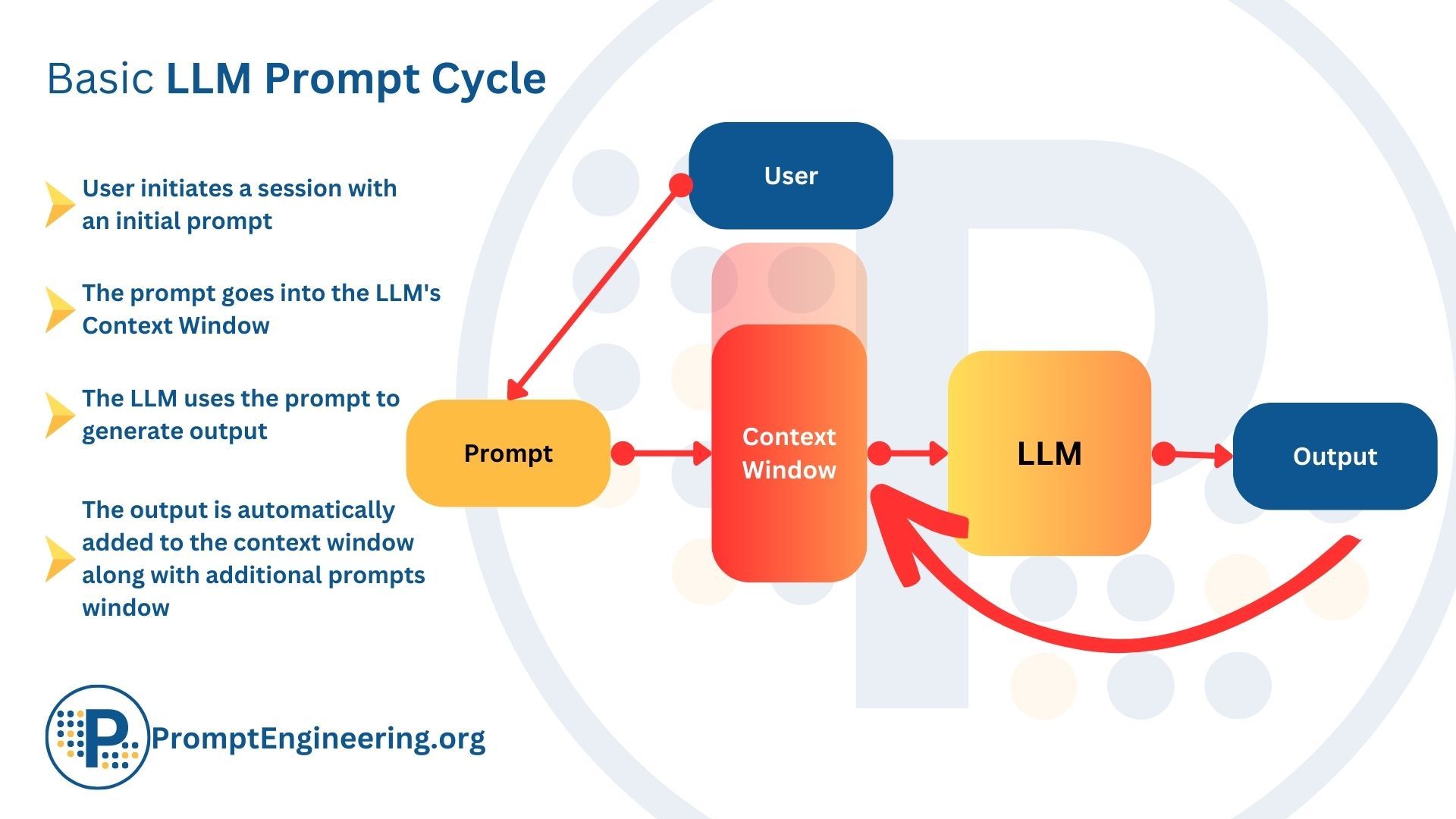
The cyclic nature of the prompt engineering framework allows users to efficiently direct LLM agents in an interactive, dynamic manner. Each iteration further trains the agent to align with the user's needs.
What Makes a Good AI Prompt?
An AI prompt is a carefully crafted piece of text or other input that is provided to an artificial intelligence system to elicit a desired response. AI prompts serve as instructions that communicate a user's intentions to the underlying machine-learning model.
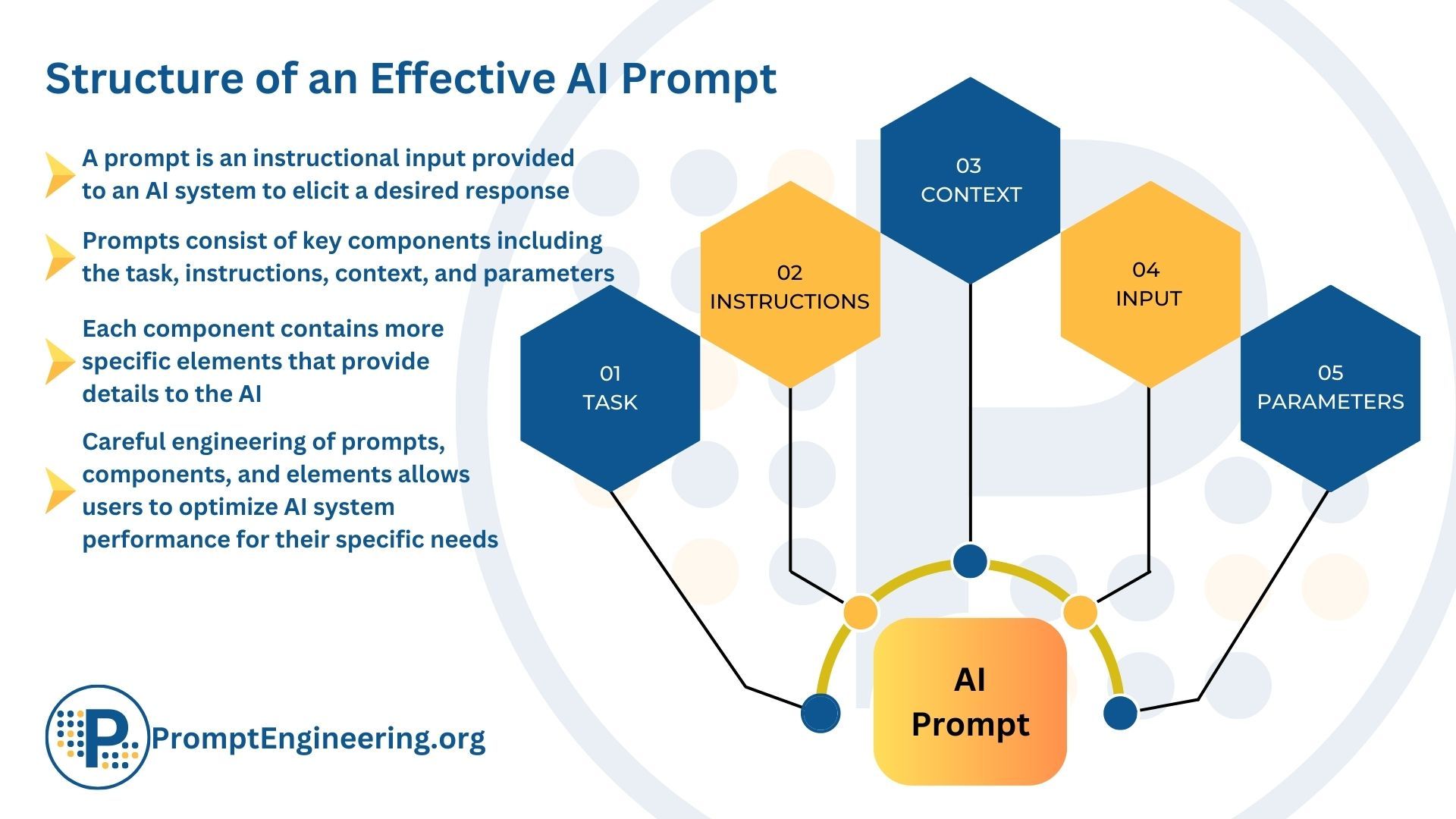
The structure and content of prompts are critical for successfully directing AI systems. Prompts must be designed to align with the capabilities of the specific AI model being leveraged. Different AI models are trained to specialize in particular types of inputs and outputs.
When prompting generative AI systems such as large language models and image generation models, the user must provide descriptive text indicating the desired output. The phrasing and level of detail in the prompt significantly influence the quality and relevance of the AI's response.
In essence, an AI prompt encodes a user's request in natural language that the AI can process and act upon. Prompt engineering is the skill of translating ideas into optimized instructions that generate accurate, relevant, and useful AI output. Effective prompts treat the AI system like a collaborative partner, with the user carefully guiding the machine's behaviour through interactive prompting.
The Anatomy of an AI Prompt
AI prompts are composed of several fundamental building blocks that work together to provide instructions and context to AI systems. Understanding the core components of effective prompting helps users craft optimized prompts.
Task: The task defines the intended output or goal for the AI. This could be answering a question, generating an image, or producing creative content. Explicitly stating the task helps focus the AI system.
Instructions: Instructions provide specific directions to the AI on how to execute the task. This includes desired attributes of the output, formatting, content requirements, and any constraints. Instructions act as rules steering the AI.
Context: Context supplies background information to situate the task. Examples, images, and other seeds give the AI model a sense of the expected response. Context acts as flexible guidance rather than firm rules.
Parameters: Parameters are configurations that alter how the AI processes the prompt. This includes settings like temperature and top-p that affect the creativity and randomness of the output.
Input Data: For tasks like image editing, the prompt must include input data for the AI to transform. Text inputs are also needed for language models.
Carefully combining these core components enables users to efficiently prompt AI systems. Task and instructions provide direction, while context and data give the AI needed references. Parameters fine-tune the final output. Developing expertise in prompt anatomy is key for prompt engineering.
Elements Within Prompt Components
The key components of AI prompts outlined above can be further broken down into more granular elements. Each component contains numerous elements that help provide the AI system with a fully detailed set of instructions and context.
For example, the Task component contains elements like:
- Role - The persona the AI should adopt
- Command - The action verb directing the AI
- Topic - Subject matter focus area
- Query - Specific question to be answered
The Instructions component elements include:
- Output - Expected attributes of the generated content
- Structure - Organization format, sections, flow
- Do's - Acceptable qualities and content
- Don'ts - Unacceptable qualities and content
- Points/Ideas - Specific concepts to include
- Examples - Samples to illustrate the desired output
The Context component involves elements such as:
- Target Audience - Intended consumer of the content
- Perspective - Point of view to adopt
- Purpose - Goals and motivations
- Supplementary Info - Additional background details
And the Parameters component contains settings like:
- Temperature - Creativity/unpredictability level
- Length - Generated content size
- Top-p - Likelihood of unlikely outputs
- Penalty - Discouragement of unwanted outputs
- Model - AI system used
By breaking down prompts into finer elements, users can precisely tailor instructions for the AI system and achieve greater control over the output. Element-level prompt engineering unlocks enhanced prompting capabilities.
Prompt Recipes
Prompt recipes are predefined templates for constructing AI prompts in a structured format. They provide a framework combining the core components of tasks, instructions, context, and parameters into reusable patterns.
The key benefit of prompt recipes is standardization. By filling in recipe templates, users can rapidly generate new prompts with consistency across use cases. This ensures reliability and uniformity in the AI system's results.
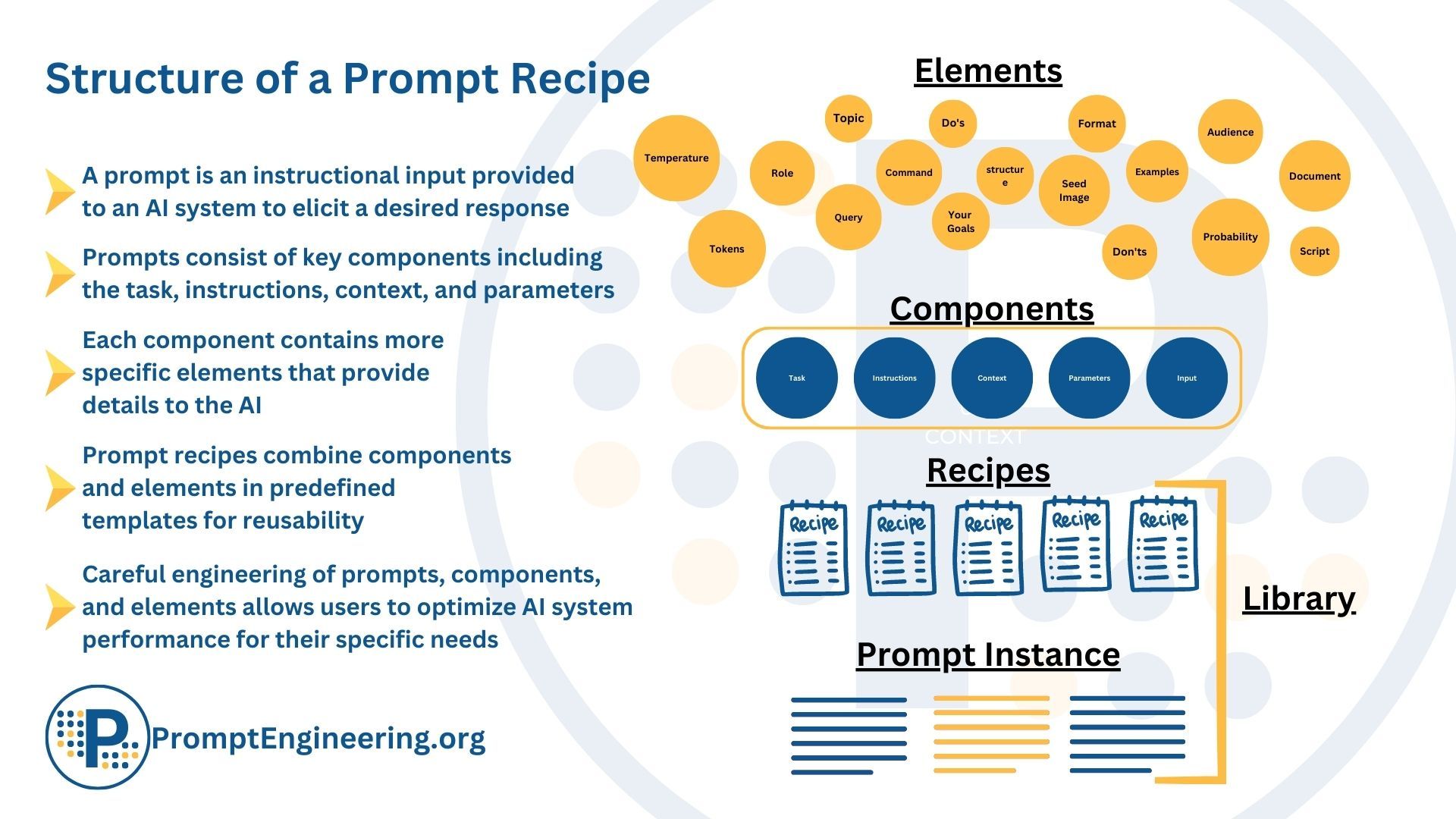
Within each recipe, certain fields are pre-filled with default settings, while other fields remain open for customization. This way, users can tailor prompts to their specific needs while maintaining the overall recipe structure. Customizable fields may include specific content requirements, target audience, desired tone, output length, creativity level, and more.
Sharing and collaboratively editing recipes facilitates optimization through iteration and testing. Recipes can be catalogued and performance tracked to identify optimal templates. Grouping recipes into projects enables organization around business domains and use cases.
Over time, users can build extensive prompt recipe libraries covering diverse scenarios and applications. New recipes can build upon elements from existing ones as knowledge compounds. Maintaining structured recipes allows users to adaptively combine a variety of techniques to push the boundaries of what's achievable with AI prompting.
Structure of Large Language Model Agents
So what exactly goes into constructing these agents? Turning raw language models into capable, autonomous agents requires carefully integrating the core LLM with additional components for knowledge, memory, interfaces, and tools.
While an LLM forms the foundation, three key elements are essential for creating agents that can understand instructions, demonstrate useful skills, and collaborate with humans: the underlying LLM architecture itself, effective prompt engineering, and the agent's interface.
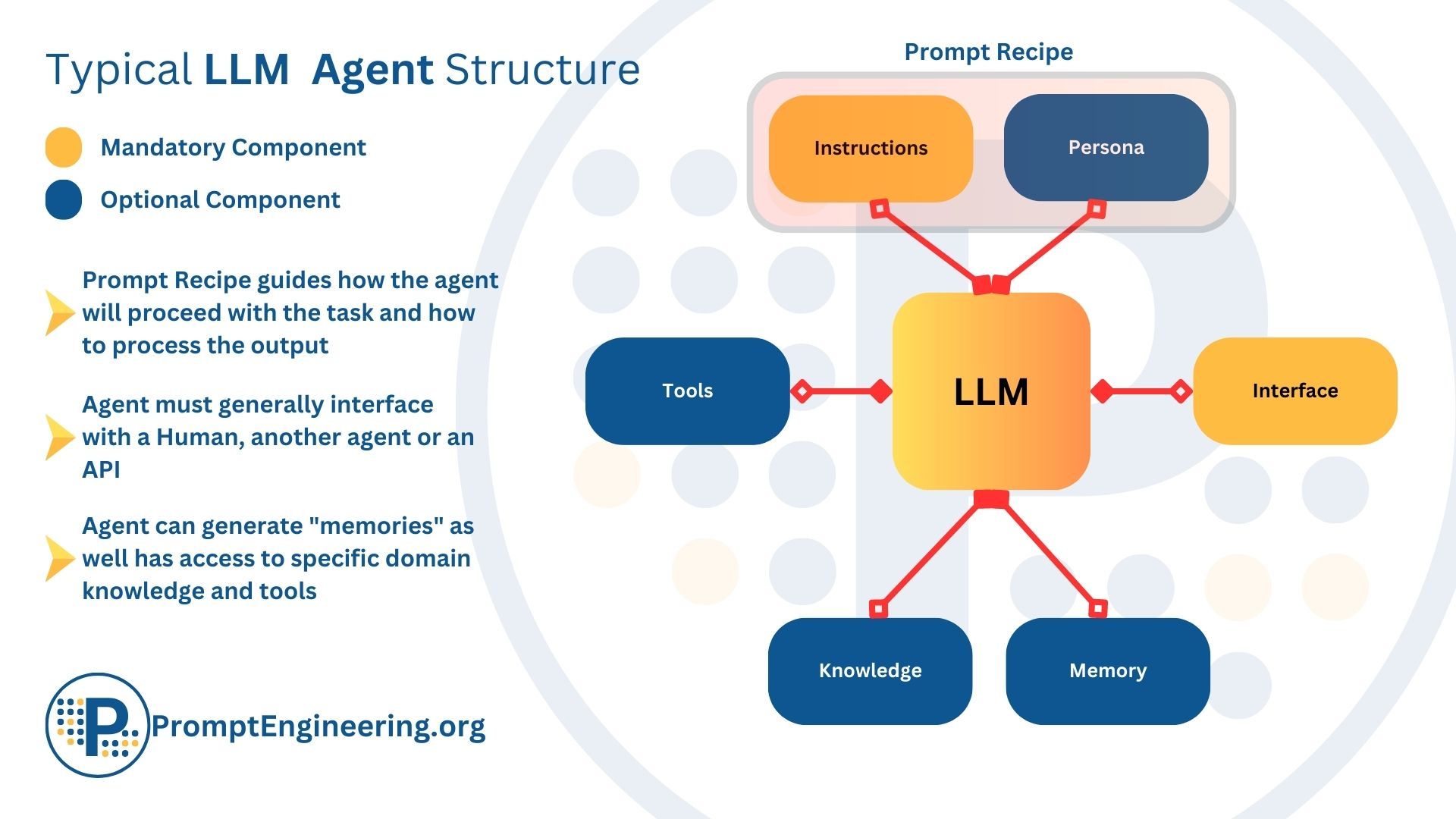
Let us explore these core components that upgrade LLMs from passive text generators into active, semi-autonomous agents. Understanding the ingredients involved in agent creation uncovers the opportunities and considerations in deploying these AI systems for real-world assistance. We will break down what exactly transforms an LLM into an LLM agent.
The LLM Core
The foundation of an LLM agent is the underlying large language model itself. This neural network, trained on vast datasets, provides basic text generation and comprehension capabilities. The size and architecture of the LLM determine the agent's baseline aptitudes and limitations.
Prompt Recipe
Equally important is effective prompt recipes to activate and direct the LLM's skills. Carefully crafted prompts give the agent its persona, knowledge, behaviours, and goals. Prompt recipes offer pre-defined templates combining key instructions, contexts, and parameters to consistently elicit desired agent responses.
Personas embedded in prompts are essential for conversational agents to adopt unique speaking styles. For task-oriented agents, prompts break down objectives, provide relevant knowledge, and frame instructions.
Interface and Interaction
The interface determines how users provide prompts to the agent. Command line, graphical, or conversational interfaces allow varying levels of interactivity. Fully autonomous agents may receive prompts programmatically from other systems or agents via the API.
The interface influences whether agent interactions feel like a back-and-forth collaboration versus a self-directed assistant. Smooth interfaces keep the focus on the prompts themselves.
Memory
Memory provides temporal context and records detail specific to individual users or tasks. Two forms of memory are typically employed in agents:
- Short-term memory - The LLM's innate context window maintains awareness of recent conversational history or recent actions taken.
- Long-term memory - An external database paired with the LLM to expand recall capacity for facts, conversations, and other relevant details from further in the past. Long-term memory equips the agent with a persistent, cumulative memory bank.
Memory gives the agent grounding in time and user-specific experiences. This context personalizes conversations and improves consistency in multi-step tasks.
Knowledge
Whereas memory focuses on temporal user and task details, knowledge represents general expertise applicable across users. Knowledge expands what the LLM itself contains within its model parameters.
- Specialized knowledge - Supplements the LLM's foundations with domain-specific vocabularies, concepts, and reasoning approaches tailored to particular topics or fields.
- Commonsense knowledge - Adds general world knowledge the LLM may lack, such as facts about society, culture, physics, and more.
- Procedural knowledge - Provides know-how for completing tasks, such as workflows, analysis techniques, and creative processes.
Injecting knowledge expands what an agent can comprehend and discuss. Knowledge stays relevant even as memory is reset or adapted across tasks. The combination enables knowledgeable agents with personalized memories.
Keeping memory and knowledge implementation separate maximizes flexibility in configuring agents for diverse needs. Agents can integrate different knowledge sources with user-specific memory stores that accumulate over time.
*Keeping Memory & Knowledge Logically Separate
Implementing separate external memory and knowledge stores for LLM agents provides a number of benefits including:
- Enables analyzing how an agent's reasoning skills evolve over time as its memory accumulates while its knowledge remains fixed. Comparing outputs over time isolates the impact of expanding memory.
- Allows selectively "flashing" an agent's memory without losing general knowledge. This is useful for taking on new projects where prior contextual memories could introduce bias. Erasing memory while retaining knowledge focuses the agent strictly on the new task context.
- Secures an agent's vetted knowledge base from potentially malicious memory modifications through errant prompts or data injections. Separate stores keep trusted knowledge pristine.
Overall, decoupling external memory from injected knowledge increases the agility, interpretability, and security of LLM agent behaviours as they tackle diverse tasks and build longitudinal experiences. Architectural separation maximizes the utility of both components.
Tool Integration
Agents need not act solely through language generation - tool integration allows completing tasks through APIs and external services. For example, an agent could use a code execution tool to run software routines referenced in a prompt, or "plugins" such as OpenAi's code interpreter.
In summary, LLM agents integrate powerful core capabilities with supplementary components to exhibit their impressive capacities. The underlying LLM provides the base language skills, while prompt recipes direct those abilities towards goals and personas. Interfaces enable interaction, and additional memory and knowledge improve contextual understanding.
Together, these ingredients enable collaborative, semi-autonomous agents that can understand natural language, reason about prompts, accumulate memories and take informed actions. LLM agents have moved beyond passive language modelling to become capable partners in assisting humans across an enormous range of conversational and task-oriented domains.
However, their performance and alignment ultimately depend on the quality of the prompts they receive. Thoughtful prompt engineering remains the key driver for unlocking greater intelligence and usefulness from LLMs as they transition into increasingly capable agents.
Two Major Types of LLM Agents
Large language models have enabled a new generation of AI agents with impressive capabilities. These LLM-based agents can be categorized into two key types based on their primary functions: conversational agents and task-oriented agents.
While both leverage the power of language models, these two agent types have important distinctions in their goals, behaviours, and prompting approaches.
Conversational agents focus on providing an engaging, personalized discussion, while task-oriented agents work towards completing clearly defined objectives.
In the sections below, we will explore the characteristics and prompting considerations unique to each type of LLM agent. Understanding the differences allows users to select and direct the appropriate agent for their needs.
1. Conversational Agents: Simulating Human Dialogue
Recent advances in natural language processing have enabled remarkable conversational capabilities in AI systems like ChatGPT and GPT-4. These conversational agents can engage in impressively human-like dialogues, understanding context and responding with realistic statements.
Conversational agents, such as Synthetic Interactive Persona Agent (SIPA), take on personalities defined by prompts that characterize their tone, speaking style, opinions, and domain knowledge. This allows nuanced discussions as users interact with the personified agent.

A major appeal of conversational agents is their ability to mirror human tendencies in the discussion. The agents account for factors like tone, speaking style, domain knowledge, opinions, and personality quirks when formulated via prompt engineering. This allows nuanced, contextual interactions.
In applications like customer service chatbots, conversational agents can leverage persona prompts to shape responses that feel natural and empathetic. Their capabilities in language understanding and generation make the conversations feel fluid and adaptive.
Conversational agents also open doors for gathering information interactively that mirrors human-human discussions. They can adopt domain expertise through prompts to serve as informed advisors or specialists, such as in medical or legal fields.
Conversational agent providers continue to enhance memory, knowledge integration, and response quality capabilities. Over time, these AI systems may have sufficient capabilities to pass extended Turing tests and serve as fully featured virtual assistants.
Conversational agents powered by language models mark a major evolution in human-computer interaction. Their ability to engage in productive, personalized dialogue through prompt engineering unlocks new possibilities across many sectors and applications.
2. Task-Oriented Agents: Goal-Driven Productivity
In contrast to conversational agents, such as those present in Generative AI Networks (GAINs), task-oriented AI agents focus squarely on achieving defined objectives and completing workflows. These goal-driven systems excel at breaking down high-level tasks into more manageable sub-tasks.

Task-oriented agents leverage their robust language modelling capabilities to analyze prompts, extract key parameters, formulate plans, call APIs, execute actions through integrated tools, and report back on results. This enables the automated handling of multifaceted goals.
Prompt engineering equips task-oriented agents with skills in strategic task reformulation, chaining lines of thought, reflecting on past work, and iterative refinement of methods. Contemporary problem-solving techniques can also be encoded into prompts to strengthen analysis and planning.
With sufficient access to knowledge and tools, task-oriented agents can function semi-autonomously, driven by a prompt-defined objective. Their work can be reviewed asynchronously by human collaborators.
Groups of task-oriented agents can also coordinate through a centralized prompting interface. This allows assembling teams of AI agents, each with complementary capabilities, to accomplish broad goals. The agents handle distinct sub-tasks while working cohesively towards the overall aim.
In the future, enterprise-grade task automation and augmentation will increasingly leverage goal-focused agents. Their specialized prompting empowers agents to not just understand natural language prompts, but act upon them to drive progress and productivity.
What Makes an LLM Agent Autonomous?
For an LLM agent to demonstrate meaningful autonomy, it cannot just respond to individual prompts in isolation - it must be continuously directed in an ongoing process. This raises the question: what provides this continuous prompting that enables self-governing behaviour?
A key limitation of current LLMs is that they cannot independently perform recursive self-loops to prompt themselves recursively. An LLM cannot inherently question its own outputs and re-prompt itself without external intervention.
True autonomy requires an external system for reviewing the agent's responses, providing guidance and corrections if needed, and supplying follow-up prompts that build on the context. This automated prompting system acts as a supervisor curating the agent's ongoing learning and improvement.
In most cases, this supervisor system is another AI agent, very often an LLM itself. Two agents work in tandem - one generating responses and another reviewing and re-prompting the first agent as needed. Multi-agent interaction creates the training loops that evolve autonomous skills.
The supervisor agent examines the generated agent's work, supplies follow-up prompts and instructions, and provides interactive feedback. This coupled prompting relationship, mediated through an API, scaffolds the generated agent's progression from narrow capacities towards general intelligence.
In essence, autonomy emerges from the interplay between agents in a prompting ecosystem. Autonomous skills are cultivated through persistent prompting from a dedicated supervisor agent providing direction, corrections, and increasing challenges. Ongoing prompting unlocks growth in reasoning, effectiveness, and self-directed determination.
Benefits of an Agent-Based Approach
Employing AI systems as interactive, semi-autonomous agents powered by language models provides a range of advantages:
- Security - Agents can be containerized and connected through secure APIs to limit risks. Their interactions are monitored and vetted.
- Modularity - Agents with different capabilities can be assembled and coordinated as needed. Adding or swapping agents is straightforward.
- Flexibility - Agent roles and behaviors are directed through prompting, allowing dynamic configuration.
- Automation - Agents require less constant human oversight compared to more rigid AI systems.
- Specialization - Agents can build deep expertise in specific domains based on focused prompting strategies.
- Quality - Monitoring agent conversations enables ongoing improvement of prompts for greater accuracy and relevance.
- Privacy - Sensitive user data can remain compartmentalized while agents operate on derivatives.
Overall, the agent-based paradigm offers a sweet spot between human control and AI autonomy. Agents collaborate with human prompting, improving through iteration. Architecting AI assistants as purpose-driven agents unlocks many benefits.
Takeaway
Large language models are rapidly evolving from passive text generators into versatile, semi-autonomous and autonomous agents. Careful prompt engineering activates conversational and task-driven abilities from the LLM core. Supplementary components like knowledge banks, tool integration, and memory enable agents to demonstrate expanded reasoning and expertise.
Conversational agents can engage users with personalized dialogues and domain-specific advice. Task-oriented agents marshal their skills towards executing workflows and objectives. Architected properly, LLM agents provide the flexible intelligence to collaborate with humans across an enormous range of applications.
Yet their ultimate potential remains tied to the quality of the prompts they receive. Developing the art and science of prompt engineering is key to directing these systems securely and productively. As prompts improve, so too will the capabilities of LLM agents, unlocking new frontiers in AI assistance.









